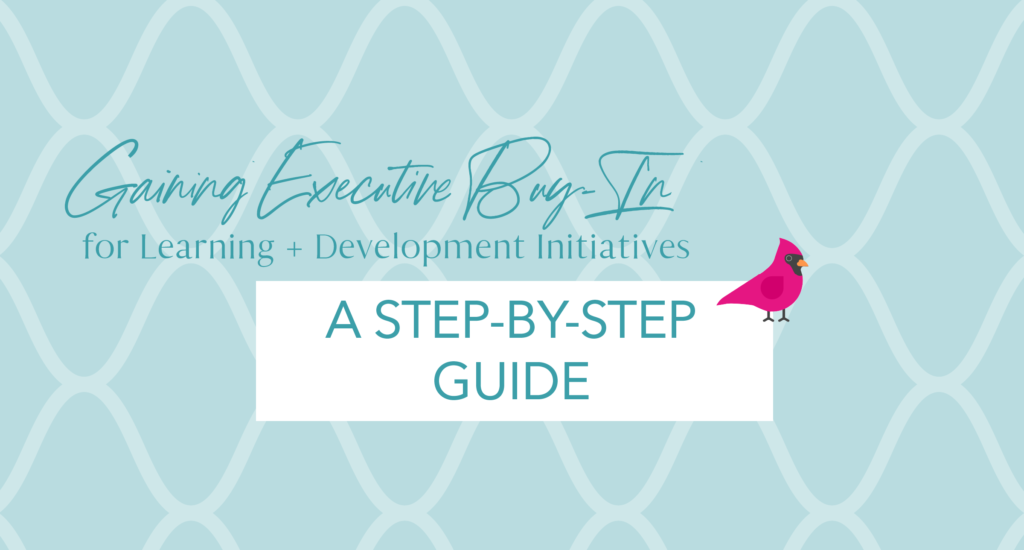
Securing executive buy-in for Learning + Development (L+D) programs isn’t just about getting the green light on funding—it’s about ensuring these initiatives are seen as a critical part of the company’s overall strategy. So, how do you get leadership fully on board? Follow these steps to make sure your L+D initiatives not only align with business goals but also have strong executive support from the start.

Executives are laser-focused on the big picture: how is this going to impact the bottom line? You need to show that your L+D programs aren’t just “nice-to-haves”—they’re drivers of real business outcomes.
- Understand Strategic Objectives: Get familiar with your company’s long-term goals, challenges, and priorities. The more you understand where the business is headed, the better you can tailor your L+D initiatives to support those goals.
- Map L+D to Business Outcomes: Make the connection crystal clear. For example, if the company’s goal is to improve customer satisfaction, explain how your training will enhance customer service skills and drive that metric.

Let’s face it: decision-makers love data. To secure their buy-in, you need to back up your L+D proposals with hard numbers and a solid case for why these programs are necessary.
- Use Metrics + Analytics: Show the current state of employee skills, where the gaps are, and how those gaps are affecting business performance. Make it clear that training is the solution to these issues.
- Show ROI: Use case studies and industry data to highlight the return on investment (ROI) for similar programs. Demonstrating how L+D initiatives have led to measurable improvements in other companies or your own team will strengthen your case.

Building relationships with execs and getting them involved from the start is key. When they feel included and invested, they’re more likely to support and advocate for your initiatives.
- Schedule Regular Meetings: Don’t wait until you need something—set up regular check-ins with key stakeholders to discuss L+D strategies and get their input. This helps keep your programs aligned with shifting business priorities.
- Seek Input + Feedback: Ask for their insights early on, and be open to their feedback. When executives feel like they’ve contributed, they’re far more likely to champion the program.

Leadership development is something every executive can get behind. Strong leaders are essential to driving the company’s future success, and L+D plays a crucial role in developing that leadership pipeline.
- Focus on the Leadership Pipeline: Show how investing in L+D will build a robust bench of future leaders. This ensures the company has the talent needed to tackle tomorrow’s challenges.
- Align with Succession Planning: Make the case that L+D supports succession planning by developing high-potential employees, preparing them for leadership roles down the line.

Sometimes, seeing is believing. Share real success stories—either from within your own organization or from industry peers—demonstrating how similar L+D programs have made a tangible impact.
- Share Internal Success Stories: Point to examples of previous L+D initiatives that have delivered measurable improvements. This helps prove that your programs can deliver real, actionable results.
- Use Industry Benchmarks: Highlight how other companies in your industry have benefited from similar initiatives. This provides external validation that your approach is tried and tested.

When you’re talking to executives, focus on the business impact. They want to know how L+D programs will affect revenue, efficiency, and customer satisfaction—not just the educational benefits.
- Use Business Language: Frame everything in terms of business outcomes. For example, show how reducing skills gaps will lead to increased productivity, higher revenue, or improved customer satisfaction.
- Highlight Cost Savings: If applicable, demonstrate how L+D programs can reduce turnover, lower recruitment costs, or minimize downtime caused by skill shortages. Executives love seeing potential savings!

A well-structured business case is essential for getting buy-in. Make sure it covers the problem, the solution, the benefits, and the resources you’ll need.
- Outline the Problem: Clearly define the business challenge or opportunity that your L+D initiative will address. Use data to paint a clear picture of the problem.
- Propose a Solution: Detail how your L+D program will solve the problem. Explain why your approach is the best fit for tackling this specific challenge.
- Detail the Benefits: Be specific about the quantitative and qualitative benefits, and connect them back to the company’s strategic goals.
- Identify Required Resources: Lay out exactly what’s needed to get the program off the ground. Be realistic about the budget, timelines, and any technology or personnel requirements.

Once you’ve secured buy-in, keep the momentum going. Regularly update executives on the progress and success of your L+D initiatives. This reinforces the value and ensures continued support.
- Provide Regular Reports: Share progress updates, key metrics, and success stories. This keeps leadership engaged and shows that the investment is delivering results.
- Solicit Feedback: Keep asking for feedback and make adjustments based on what you hear. This shows you’re committed to continuous improvement and value executive input.

Early wins can be powerful. Highlight quick successes to demonstrate that the program is making an impact and is worth the investment.
- Highlight Early Successes: Whether it’s an improvement in employee performance or positive feedback from participants, quick wins help keep executives excited and supportive.
- Use Pilot Programs: Consider starting with a smaller-scale pilot program to show proof of concept. Once executives see the initial results, they’ll be more likely to champion a broader rollout.
By following these steps, you’ll be in a strong position to secure executive buy-in for your L+D initiatives. With senior leadership on board, your programs will have the support they need to align with business goals and deliver real impact.

Leave a Reply